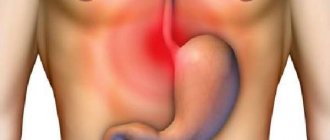What happens during vomiting?
Vomiting is a protective reflex in which the contents of the stomach and initial parts of the intestines are returned through the mouth.
As a rule, it is preceded by nausea. It is caused by irritation of the receptors of the gastrointestinal tract (GIT) or a direct effect on the vomiting center, which is located in the brain stem. The gag reflex is realized by contracting the diaphragm, intercostal and abdominal muscles with the simultaneous opening of the lower esophageal sphincter, which normally prevents the return of food from the stomach into the esophagus. At the same time, the epiglottis closes and breathing stops, which prevents vomit from entering the respiratory tract.
As a result, the contents of the stomach, including enzymes and fluid, leave the body through the oral cavity. Also, due to the activation of the autonomic nervous system, salivation increases and sweating occurs. All this leads to loss of fluid - dehydration, which becomes a serious problem with prolonged vomiting.
Foreign body of the esophagus, stomach, intestine
Often, nausea can occur due to pathological impulses from the walls of the esophagus or stomach, less often from the intestines, when foreign bodies enter them. They can be fruit seeds, small toys, objects that, due to their sharp edges and dense structure, irritate the delicate mucous membranes and injure them. You can expect similar nausea that occurs suddenly against the background of preliminary full health in children of the first 2-3 years, who could be left unattended while eating or playing with small objects. Nausea often develops some time (not long) after a foreign object enters the digestive tract.
What to do?
It is necessary to immediately show the child to a surgeon, perform radiography or fibrogastroduodenoscopy with simultaneous detection and removal of the object. Attempting to induce vomiting, taking laxatives, or otherwise attempting to independently remove foreign objects is prohibited.
Causes of vomiting in a child
Vomiting is one of the most common symptoms in children and can be associated with a wide variety of diseases and disorders of the gastrointestinal tract, nervous system, functional disorders and other reasons.
Intestinal infection in children
The most common cause of vomiting is gastrointestinal infections (video 1). As a rule, they occur when eating contaminated food or water, as well as when personal hygiene is not observed. Clinical manifestations may vary significantly depending on the specific disease.
The most common types of intestinal infections in children are:
- Intestinal flu (rotavirus infection), caused by viruses from the Reoviridae family. It is transmitted through contaminated water and through direct contact with a sick person.
- Viral gastroenteritis. In addition to rotaviruses, inflammation of the stomach and small intestine can also be caused by other viruses: adenovirus, norovirus, astroviruses.
- Salmonellosis, caused by Salmonella bacteria. Typical sources of infection are eggs, meat, poultry, milk and products prepared on their basis, for example, confectionery creams.
- Dysentery (shigellosis). The causative agent is bacteria of the genus Shigella. It can be transmitted through water, food (most often milk and dairy products), as well as through household items.
- Eschirichiosis (travelers' diarrhea), caused by bacteria from the genus Escherichia, often by Escherichia coli (E. Coli). Transmission factors include: water, dairy products, prepared meat products, drinks, as well as household items, such as toys.
- Listeroiosis. The causative agent is Listeria monocytogenes. Most often detected in semi-finished meat products and ready-to-eat meat products (canned food, sausages), soft cheeses and cold smoked fish products.
Infectious lesions of the gastrointestinal tract in children, in addition to vomiting, also cause other symptoms, such as diarrhea, fever, abdominal pain, slow weight gain, etc.
Video 1. What to do if you have an intestinal infection.
Diseases of the digestive organs
Another common cause of vomiting in childhood is diseases of the gastrointestinal tract. Most often this is:
- Gastritis is inflammation of the gastric mucosa.
- Duodenitis is inflammation of the duodenum.
- Pancreatitis is inflammation of the pancreas.
- Cholecystitis is inflammation of the gallbladder.
- Intestinal obstruction.
In infancy, constant regurgitation may be associated with pyloric stenosis and pyloric spasm. Pyloric stenosis is a structural deformation of the pylorus of the stomach, which prevents food from passing into the duodenum. With pylorospasm, similar changes occur, but they are temporary, since they are caused by increased tone of the stomach muscles.
What symptoms indicate problems with the gastrointestinal tract?
Common symptoms that suggest the development of gastrointestinal diseases in children are:
- Pain in various areas of the abdomen that occurs immediately after eating or after some time.
- Bowel disorders: diarrhea or constipation.
- Pathological impurities in feces, undigested food particles.
- Flatulence, belching sour or rotten.
Food poisoning in a child
Food poisoning, as well as infectious diseases of the gastrointestinal tract, are caused by eating contaminated food. However, in food poisoning, the key role is played not by the bacteria themselves, but by their metabolic products, released into the nutrient medium in which these bacteria have been present for a long time. Thus, a large amount of bacterial toxins enters the child’s body at once, which causes vomiting and other symptoms of poisoning.
Vomiting may be a sign of poisoning. Photo by Mac DeStroir from Pexels
The previously mentioned salmonella, as well as the bacteria Clostridium botulinum, which causes botulism, can release large amounts of toxins into products. The cause of the development of botulism is most often low-quality canned food, pickles, as well as insufficiently thermally processed meat and fish.
Important! Vomiting is one of the first reactions to eating foods unsuitable for food, for example, poisonous mushrooms, berries or raw meat.
Acute appendicitis
Acute appendicitis is an acute inflammation of the appendix (the vermiform appendix of the cecum). It is one of the most common surgical pathologies of the abdominal cavity.
Often, the first signs of appendicitis in childhood are constant acute pain in the abdomen, which later moves to the right iliac region, and an increase in body temperature up to 37.5 ° C (Fig. 1). In addition, nausea and vomiting once or twice often occur.
Acute appendicitis requires immediate surgical intervention - removal of the inflamed appendix of the intestine.
Figure 1. Classic symptoms of an “acute abdomen” that often accompany acute appendicitis. Source: Adobe Stock
Foreign body in the esophagus
A common cause of vomiting in childhood is the ingestion of foreign bodies, often small toys or their parts, for example, construction parts. Moreover, it is paroxysmal in nature, is in no way connected with meals, and the gag reflex may not be accompanied by evacuation of the stomach contents at all. In such cases, seeking medical help is indicated.
Acetone vomiting in children
Cyclic acetonemic vomiting syndrome is a set of manifestations that arise as a result of a sharp increase in the level of ketone bodies in the child’s blood plasma.
This condition may be the result of constitutional abnormalities (neuroarthritic diathesis) or prolonged fasting, the body's reaction in the postoperative period, or the manifestation of certain diseases and conditions: severe infections or endocrine pathologies (diabetes mellitus).
A characteristic feature of acetone vomiting in children is the cyclical nature of episodes that occur at regular intervals - from 15 to 60 minutes. Between them, the child, as a rule, feels satisfactory. Also noted: the smell of acetone from the mouth, increased body temperature and diarrhea.
Neurological disorders in children
The gag reflex can be provoked by a direct effect on the medulla oblongata, the part of the brain stem in which the so-called vomiting center is located. This occurs with concussion due to traumatic brain injury, with infectious lesions of the central nervous system (meningitis, encephalitis) and increased intracranial pressure due to hydrocephalus.
Neurotic or psychogenic vomiting in a child
In children of preschool and early school age, vomiting can be caused by strong emotional experiences, fear or stress. Associated phenomena are often surges in blood pressure, increased sweating, pallor, dizziness and general weakness.
Vomiting due to motion sickness
Children are more prone to kinetosis or motion sickness. It manifests itself with nausea and vomiting against a background of monotonous, prolonged fluctuations and occurs during long journeys by car, on buses and trains, or on a sea vessel. This pathology is also accompanied by dizziness, general weakness, pallor and sweating (video 2).
The mechanism for the development of motion sickness is the prolonged irritation of the vestibular apparatus located in the inner ear. Normally, he perceives the position of the body in space. However, when traffic is moving, the information received visually is often perceived by the brain as a static position, although some movement occurs. This heterogeneity of information received is what causes motion sickness.
Video 2. What to do if a child gets motion sickness.
Symptoms of intoxication in the presence of vomiting
In case of poisoning, infectious and inflammatory diseases, vomiting is accompanied by the so-called intoxication syndrome.
This is a set of symptoms caused by the entry into the blood of various toxins, tissue breakdown products, etc. Intoxication syndrome, in addition to possible nausea and vomiting, includes:
- General weakness, malaise and increased anxiety.
- Increased body temperature to 37-40°C and increased sweating.
- Loss of appetite.
- Headache, which at a young age is manifested by constant, sometimes monotonous crying.
Prevention of food poisoning
To prevent food poisoning, give your child only clean and properly processed food. There are four steps to ensuring your food is free of pathogens:
- thorough cleaning. Before preparing food, you must wash your hands, kitchen utensils, fresh vegetables and fruits under running water using special products;
- protection against cross contamination. Raw foods should not be allowed to come into contact with cooked foods: eggs, raw meat, poultry and fish should be stored in separate containers and cut on separate cutting boards. This will prevent bacteria from getting from raw food into prepared dishes;
- heat treatment. Most bacteria and viruses are killed when heated above 100℃;
- quick freezing. If you store frozen food, make sure the freezer compartment is kept at a low enough temperature and remember to wipe it down periodically.
By using these rules, you guarantee that your child will not be poisoned by homemade food. But this is not enough: he can catch an intestinal infection outside the home. Therefore, it is necessary to teach children to observe the rules of personal hygiene from an early age. Explain to your child that it is necessary to wash your hands before eating; you cannot eat vegetables and fruits without washing them.
Also, resistance to food poisoning is higher if the child has a strong immune system. To strengthen children's immunity it is recommended:
- lead an active lifestyle - do gymnastics with your child, enroll him in a sports section;
- take regular walks – if it’s cold outside, make sure to wear clothes that are appropriate for the season;
- develop a daily routine - it is especially useful for preschool children. Adequate sleep and eating at the same time allow the child’s body to better cope with stress and resist infectious agents;
- balance your diet. Dysbacteriosis further weakens the immune system and increases the risk of food poisoning.
In the warm season, you should not prepare food for future use - pathogenic microflora quickly develops in it. Under 5 years of age, you should not include dishes with mushrooms, pickled and salty foods in your child’s diet. There is a high probability that the baby’s body will not cope with them and poisoning will develop. If you buy finished products (for example, baked goods), make sure that the manufacturer has all the necessary sanitary permits. It is better not to give street food to children. Detailed recommendations on feeding children can be obtained during a consultation with a pediatrician or pediatric gastroenterologist.
0
1
3
Article rating:
4.44 out of 5 based on 9 ratings
Author: Mikusko-Petrova Olga Zosimovna
Pediatric gastroenterologist. Highest category. Work experience 13 years.
What to do in case of vomiting?
The actions of parents depend on the causes of development and characteristics of the vomit. If vomiting is one-time and is not accompanied by other symptoms, no special action is required from parents. Otherwise, it is recommended to follow these recommendations:
- Constantly monitor the child. The baby should be held vertically in your arms; older children should be placed on their side or brought into a semi-sitting position. This will prevent you from inhaling vomit.
- After an attack of vomiting, rinse the baby's mouth with clean water using a bulb or a large syringe. Older children should be helped to rinse their mouths.
- Avoid using any medications on your own without knowing the cause of vomiting. At best, the pills will simply come out along with a new portion of vomit; at worst, they can cause harm and complicate diagnosis.
Excessive vomiting in children is accompanied by dehydration due to significant loss of fluid along with vomit. Therefore, it is important to restore losses with the help of mineral waters, special solutions, and in their absence - ordinary water.
If possible, the child should be given something to drink when vomiting. Photo: AndrewLozovyi / Depositphotos
Pathologies of the nervous system, trauma, brain tumors
Damages to the central organs regulating all vital functions - the brain or spinal cord in children, as well as problems with the response of the peripheral nervous system can cause nausea . In this case it has a neurogenic (central) character. In children and adolescents, nausea also predicts or accompanies migraines.
note
Often painful and almost constant nausea accompanies serious and dangerous pathologies, injuries or lesions of the central parts - meningitis or encephalitis, and it also often forms as a reaction to a concussion or contusion of the brain.
This kind of nausea can occur either in isolation or accompanied by rare bouts of vomiting that does not bring relief; there may be severe headaches and dizziness, double vision and disturbances of consciousness.
Neurological pathologies, along with nausea, are often accompanied by a general disorder - excitability or lethargy of children, their sharp tearfulness and whims, refusal to eat, regurgitation, decreased motor activity, prolonged sleep or insomnia.
At an early age, nausea is accompanied by heart-rending screams and hysterics, bulging fontanel, hysterics, neurological symptoms and fear of light. Fever and convulsions may occur, often with complete loss of consciousness, which is life-threatening and requires immediate calling an ambulance and hospitalization for examination in a hospital.
In what cases should you consult a doctor?
If vomiting is persistent and accompanied by other alarming symptoms, you should seek medical help as soon as possible. You should call a doctor at home if:
- Vomiting appeared immediately after a traumatic brain injury.
- Vomiting is accompanied by an increase in body temperature.
- The vomit is bright green or yellow-green in color and contains blood or brown vomit that resembles coffee grounds.
- Vomiting is accompanied by severe abdominal pain.
- Rashes appeared on the child's body.
- There is a suspicion of ingestion of foreign bodies.
- There is a suspicion of ingestion of toxic substances.
There are signs of severe dehydration: lack of urination for more than 3 hours, dry skin, tongue and mucous membranes, crying without tears, pathological drowsiness and irritability, “recession” of the abdomen and cheeks.
Rash and vomiting are a reason to call a doctor. Photo: natulrich/Depositphotos
Morning sickness, malaise
The appearance of nausea in the morning, in addition to problems with digestion, can be a symptom of intracranial hypertension , so it is necessary to visit a neurologist and conduct a full examination. You may feel sick in the morning due to stress, anxiety before an important event - this is the so-called “bear disease”, hyperexcitability of the parasympathetic part of the nervous system due to the powerful release of stress hormones. It can manifest itself not only with nausea, but also with diarrhea, constipation, bloating and pain, dizziness and panic, and a feeling of lack of air. In this situation, talking with the baby, calming down and taking light sedatives (drops, herbal teas, syrups, decoctions) will help.
Treatment of vomiting in children
The general treatment of vomiting depends on its origin. For example, in case of food poisoning, the main role in first aid is played by gastric lavage as soon as possible and the use of enterosorbents (activated carbon).
Treatment of vomiting, in addition to eliminating the main cause of its occurrence, includes restoring water and electrolyte balance. This is especially important in case of severe, prolonged and frequently repeated vomiting, due to which the body loses a large amount of fluid.
To compensate for the loss of fluid, ordinary mineral waters, slightly sweetened tea or special solutions are used, powders for the preparation of which can be purchased at the pharmacy. In severe cases, intravenous drip therapy is also used.
If it is impossible to determine the cause of vomiting or eliminate it, the use of antiemetics is indicated. Depending on the situation, the following can be used:
- Anticholinergics (scopolamine).
- Neuroleptics (chlorpromazine, haloperidol).
- H1 blockers (clemastine, promethazine).
- Dopamine receptor blockers (metoclopramide and domperidone).
Sources
- Novikova V.P., Gurova M.M., Khavkin A.I. Functional nausea and vomiting in children. Questions of children's dietetics. 2020; 18(4): 36–44
- Dubrovskaya M.I., Mukhina Yu.G., Shumilov P.V., & Volodina I.I. (2007). Regurgitation and vomiting syndrome in children of the first year of life: differential diagnosis and management tactics. Pediatrics. Journal named after G.N. Speransky, 86 (6), 18.
- Forbes D., Fairbrother S. Cyclic nausea and vomiting in childhood // Aust. Fam. Physician. - 2008. - 37(1-2).
- Boles R., Powers A., Adams K. Cyclic Vomiting Syndrome Plus // J. Child Neuro. - 2006. - 21(3).
- Muminova D.A. “Nosoological structure of recurrent vomiting in children” FORCIPE, no. Application, 2021, pp. 269-270.
Stomach pathologies, hunger, gastrointestinal tract
Nausea often occurs in children in the morning, immediately after waking up, and it is associated with severe hunger , when gastric juice is actively produced or due to excessive secretion of hydrochloric acid by the walls of the organ. As a result of irritation by excess acid in the gastric walls, pathological impulses arise in the subcortical formations of the brain, and the vomiting center is irritated. Then nausea occurs, there may even be attacks of vomiting with acidic stomach contents or an admixture of bile.
Nausea may occur in the morning and with biliary dyskinesia, especially against the background of dietary errors, consumption of fatty, choleretic foods, large meals at night, and consumption of concentrated juices.
What to do?
It is important to conduct a full examination of the child, change his diet and drinking regime, make dinners lighter, and avoid snacking at night and in the late evening before bed. You need to stop drinking juices or dilute them with water in a ratio of 1:3.










